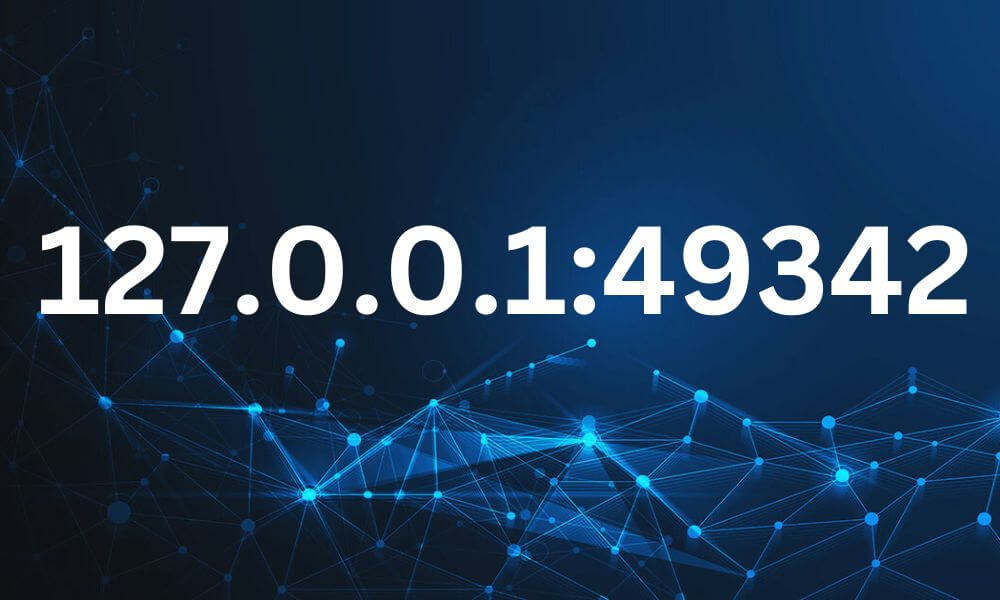Understanding 127.0.0.1:49342: Process Steps to Localhost, Fixing, and Working
The IP address 127.0.0.1 is a special address in the world of networking. Commonly referred to as “localhost,” this address is used to establish a connection to the same device that you’re working on. In essence, 127.0.0.1 points back to your own machine, making it a critical part of networking, development, and troubleshooting.
When dealing with the address 127.0.0.1 in conjunction with a port number, such as 49342, it’s essential to understand how localhost works, why it might be used, and how to troubleshoot common issues. This article will explore the concept of localhost, detail the process of working with 127.0.0.1, discuss common issues and their fixes, and explain how the combination of 127.0.0.1 and specific ports function in various contexts.
1. What is 127.0.0.1?
The IP address 127.0.0.1 is reserved for loopback connections in the IPv4 standard. This loopback function is crucial because it allows a device to send and receive network traffic to itself without the need for physical or external network interfaces.
- Loopback Interface: When you use 127.0.0.1, you are essentially bypassing the network interface and directly sending the data to your machine. This is useful for testing, debugging, and developing network services.
- Localhost: The term “localhost” is a hostname that maps to the IP address 127.0.0.1 by default. It serves as a simple and user-friendly alias for 127.0.0.1.
2. Understanding Port Numbers: The Role of 49342
In networking, a port is a communication endpoint that allows different services to run on the same IP address without conflict. For instance, a web server typically runs on port 80 for HTTP or 443 for HTTPS. The port number 49342 is an example of an ephemeral (or dynamic) port, which is typically used by the operating system to establish temporary connections.
- Ephemeral Ports: These ports are assigned automatically when an application needs to create a network connection and doesn’t need a specific port. The range for these ports is generally between 49152 and 65535.
- Application-Specific Ports: Sometimes, developers might manually bind services to specific ports within this range, depending on the application’s needs.

3. Working with 127.0.0.1:49342
To use 127.0.0.1:49342, you need to understand the context in which this address and port combination is being used. Typically, it is associated with web development, application testing, or local services.
a. Web Development
When developing web applications, developers often run a local server on their machine to test their code before deploying it to a live environment. This local server can be accessed through 127.0.0.1 and a specific port, like 49342.
- Running a Local Server: When you start a web server (e.g., using Python’s http.server, Node.js, or Apache), it will bind to an IP address and a port number. By default, many local servers will bind to 127.0.0.1 and a random ephemeral port, such as 49342, unless you specify otherwise.
- Accessing the Application: You can then access your application through a browser or a REST client using the URL http://127.0.0.1:49342. This URL will point to your locally running application, which allows you to interact with it as if it were hosted on a remote server.
b. Application Testing
Testing network applications locally before deploying them to a production environment is a common practice. Using 127.0.0.1:49342 allows developers to simulate how the application would behave when accessed over a network, without needing an external connection.
- Testing Scenarios: By binding an application to 127.0.0.1 and a port like 49342, developers can test various scenarios, such as handling multiple requests, testing APIs, and ensuring that the application can manage traffic correctly.
c. Local Services
Services like databases, caching systems, or background processes often run on localhost and are accessible via a specific port. For instance, a database might be accessible at 127.0.0.1:5432, while a local cache might be running at 127.0.0.1:6379.
- Service Access: If you have a service running on 127.0.0.1:49342, you can interact with it using clients, scripts, or other software that communicates over the network.
4. Common Issues and Fixes with 127.0.0.1:49342
Working with localhost and specific ports can sometimes lead to issues, especially when configuring services or troubleshooting network problems. Here are some common issues and how to fix them.
a. Port Already in Use
One of the most common issues is when the port 49342 is already in use by another application. This can prevent your application from binding to 127.0.0.1:49342.
- Identify the Conflict: Use tools like netstat (on Windows) or lsof (on Unix-based systems) to identify which application is using the port. For example, running netstat -ano | findstr :49342 on Windows will show you the process ID of the application using the port.
- Terminate the Process: Once you’ve identified the process, you can terminate it using the taskkill command on Windows or
killon Unix-based systems. Alternatively, you can choose to run your application on a different port.
b. Firewall Blocking
Sometimes, local firewall settings can block access to certain ports, even on localhost. This can prevent you from accessing a service running on 127.0.0.1:49342.
- Check Firewall Settings: Ensure that your firewall is not blocking the port. On Windows, you can check this in the Windows Defender Firewall settings. On Unix-based systems, check your iptables or ufw (Uncomplicated Firewall) rules.
- Allow the Port: If the port is blocked, add an exception to allow traffic through 49342.
c. Binding to the Wrong Interface
If an application is configured to bind to the wrong IP address or interface, it won’t be accessible via 127.0.0.1:49342.
- Check Configuration: Ensure that your application is explicitly configured to bind to 127.0.0.1. Sometimes, applications are configured to bind to
0.0.0.0, which listens on all interfaces but might not be what you need. - Rebind the Service: Adjust your application’s configuration to bind to 127.0.0.1 and restart the service.
d. Browser Caching Issues
When accessing web applications via 127.0.0.1:49342, sometimes you might run into caching issues that prevent you from seeing the latest version of your application.
- Clear the Cache: Clear your browser’s cache or use incognito mode to bypass the cache. This ensures you’re seeing the most up-to-date version of your application.
- Disable Caching Temporarily: While developing, you can disable caching in your browser’s developer tools to avoid such issues.

5. Ensuring Smooth Operation with 127.0.0.1:49342
To ensure that working with 127.0.0.1:49342 is smooth and error-free, follow these best practices:
a. Use a Consistent Development Environment
Set up a consistent development environment using tools like Docker, Vagrant, or virtual environments. This ensures that your application behaves the same way on all machines.
b. Document Your Port Usage
Document the ports your application uses, especially in a team environment. This prevents conflicts and makes it easier to troubleshoot issues.
c. Automate Environment Setup
Automate the setup of your development environment using scripts or configuration management tools. This ensures that the correct ports are open and that services are bound to the correct interfaces.
d. Monitor Network Traffic
Use network monitoring tools to keep an eye on the traffic going to and from 127.0.0.1:49342. This helps you catch issues early, such as unexpected spikes in traffic or unauthorized access attempts.

Conclusion
The combination of 127.0.0.1 and a port number like 49342 is a powerful tool in the arsenal of developers, network engineers, and IT professionals. Understanding how localhost works, how to manage ports, and how to troubleshoot common issues is crucial for anyone working with networked applications. By following best practices and being aware of potential pitfalls, you can ensure that your applications run smoothly and efficiently on your local machine. Whether you’re developing a web application, testing software, or running local services, mastering the use of 127.0.0.1:49342 is an essential skill in today’s interconnected world.
FAQ:
1. Is 127.0.0.1:49342 accessible from other devices on the network?
- Answer: No, 127.0.0.1 is only accessible from the local machine. If you want other devices on the network to access a service, you should bind the service to your machine’s local IP address (e.g., 192.168.1.x) instead of 127.0.0.1.
2. How do I monitor traffic on 127.0.0.1:49342?
- Answer: You can monitor traffic using network monitoring tools like Wireshark, Netstat, or Tcpdump. These tools allow you to capture and analyze network packets sent to and from 127.0.0.1:49342.
3. What are the best practices for working with 127.0.0.1:49342?
- Answer: Best practices include using a consistent development environment, documenting port usage, automating environment setup, and monitoring network traffic to ensure smooth operation and easy troubleshooting.
4. How can I avoid browser caching issues when testing with 127.0.0.1:49342?
- Answer: To avoid caching issues, clear your browser’s cache or use incognito mode. You can also disable caching temporarily in your browser’s developer tools to ensure you see the latest version of your application.
5. What are common issues when working with 127.0.0.1:49342?
- Answer: Common issues include the port already being in use, firewall blocking the port, incorrect binding to the IP address, and browser caching problems. Each of these issues can prevent access to the service running on 127.0.0.1:49342.
6. How do I resolve firewall issues when accessing 127.0.0.1:49342?
- Answer: Check your firewall settings to ensure that port 49342 is not blocked. If it is, add an exception for the port in your firewall settings. On Windows, this can be done in Windows Defender Firewall; on Unix-based systems, you can use iptables or ufw.
7. Why can’t I access my application on 127.0.0.1:49342?
- Answer: Possible reasons include the application not running, the port being blocked by a firewall, or the application being bound to a different IP address or port. Check that the application is running, ensure the port is open, and verify the binding configuration.

